Financial Analysis and Management Report for Business
VerifiedAdded on 2022/11/24
|12
|2472
|376
Report
AI Summary
This report delves into the core principles of business finance, emphasizing the significance of financial management in ensuring effective and optimal business operations. It provides a comprehensive understanding of financial management, focusing on key financial statements like the income statement and balance sheet, and their analysis. The report includes a business review, presenting an income statement and balance sheet based on a provided template. It then analyzes the company's performance using financial ratios, such as current ratio, quick ratio, gross profit ratio, net profit ratio, and inventory turnover ratio. The analysis reveals strengths in liquidity and profitability but highlights concerns regarding inventory turnover. Finally, the report recommends strategies for improvement, including cost reduction, technological advancements, and inventory management techniques to enhance financial stability and market competitiveness. The report stresses the importance of continuous improvement, efficient inventory management, and adapting to changing market dynamics for sustained financial success.

Business Finance
Paraphrase This Document
Need a fresh take? Get an instant paraphrase of this document with our AI Paraphraser

TABLE OF CONTENTS
INTRODUCTION......................................................................................................................3
SECTION 1................................................................................................................................3
Defining and discussing the concept and importance of financial management...................3
SECTION 2................................................................................................................................4
Discussing the main financial statement and use of ratios.....................................................4
SECTION 3................................................................................................................................5
i. Information on business review..........................................................................................5
ii. Showing income statement as per the template.................................................................6
iii. Showing balance sheet as per the template.......................................................................6
iv. Analyzing the performance of the company based on financial statements.....................7
SECTION 4................................................................................................................................8
CONCLUSION..........................................................................................................................9
REFERENCES.........................................................................................................................10
APPENDIX..............................................................................................................................11
INTRODUCTION......................................................................................................................3
SECTION 1................................................................................................................................3
Defining and discussing the concept and importance of financial management...................3
SECTION 2................................................................................................................................4
Discussing the main financial statement and use of ratios.....................................................4
SECTION 3................................................................................................................................5
i. Information on business review..........................................................................................5
ii. Showing income statement as per the template.................................................................6
iii. Showing balance sheet as per the template.......................................................................6
iv. Analyzing the performance of the company based on financial statements.....................7
SECTION 4................................................................................................................................8
CONCLUSION..........................................................................................................................9
REFERENCES.........................................................................................................................10
APPENDIX..............................................................................................................................11
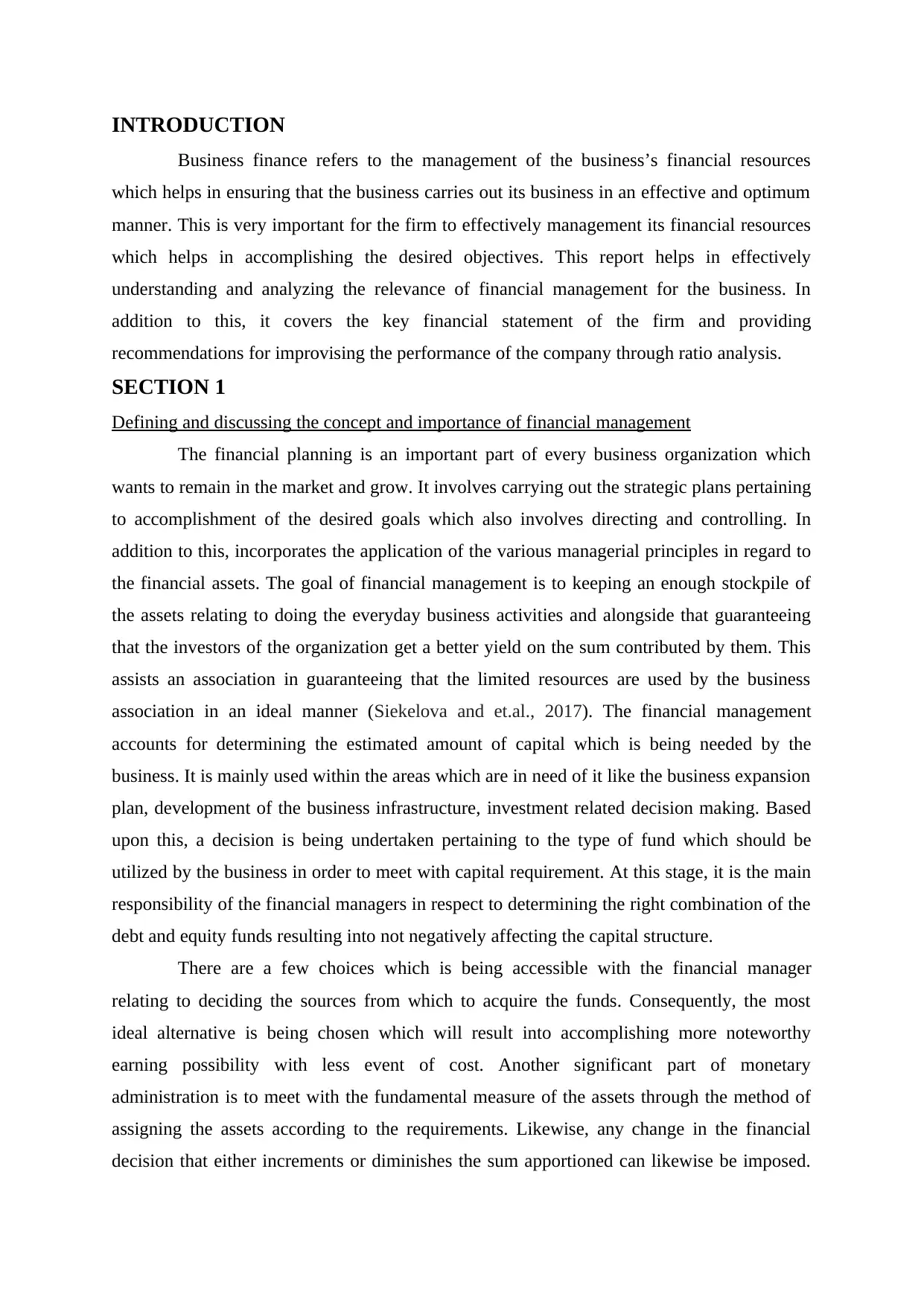
INTRODUCTION
Business finance refers to the management of the business’s financial resources
which helps in ensuring that the business carries out its business in an effective and optimum
manner. This is very important for the firm to effectively management its financial resources
which helps in accomplishing the desired objectives. This report helps in effectively
understanding and analyzing the relevance of financial management for the business. In
addition to this, it covers the key financial statement of the firm and providing
recommendations for improvising the performance of the company through ratio analysis.
SECTION 1
Defining and discussing the concept and importance of financial management
The financial planning is an important part of every business organization which
wants to remain in the market and grow. It involves carrying out the strategic plans pertaining
to accomplishment of the desired goals which also involves directing and controlling. In
addition to this, incorporates the application of the various managerial principles in regard to
the financial assets. The goal of financial management is to keeping an enough stockpile of
the assets relating to doing the everyday business activities and alongside that guaranteeing
that the investors of the organization get a better yield on the sum contributed by them. This
assists an association in guaranteeing that the limited resources are used by the business
association in an ideal manner (Siekelova and et.al., 2017). The financial management
accounts for determining the estimated amount of capital which is being needed by the
business. It is mainly used within the areas which are in need of it like the business expansion
plan, development of the business infrastructure, investment related decision making. Based
upon this, a decision is being undertaken pertaining to the type of fund which should be
utilized by the business in order to meet with capital requirement. At this stage, it is the main
responsibility of the financial managers in respect to determining the right combination of the
debt and equity funds resulting into not negatively affecting the capital structure.
There are a few choices which is being accessible with the financial manager
relating to deciding the sources from which to acquire the funds. Consequently, the most
ideal alternative is being chosen which will result into accomplishing more noteworthy
earning possibility with less event of cost. Another significant part of monetary
administration is to meet with the fundamental measure of the assets through the method of
assigning the assets according to the requirements. Likewise, any change in the financial
decision that either increments or diminishes the sum apportioned can likewise be imposed.
Business finance refers to the management of the business’s financial resources
which helps in ensuring that the business carries out its business in an effective and optimum
manner. This is very important for the firm to effectively management its financial resources
which helps in accomplishing the desired objectives. This report helps in effectively
understanding and analyzing the relevance of financial management for the business. In
addition to this, it covers the key financial statement of the firm and providing
recommendations for improvising the performance of the company through ratio analysis.
SECTION 1
Defining and discussing the concept and importance of financial management
The financial planning is an important part of every business organization which
wants to remain in the market and grow. It involves carrying out the strategic plans pertaining
to accomplishment of the desired goals which also involves directing and controlling. In
addition to this, incorporates the application of the various managerial principles in regard to
the financial assets. The goal of financial management is to keeping an enough stockpile of
the assets relating to doing the everyday business activities and alongside that guaranteeing
that the investors of the organization get a better yield on the sum contributed by them. This
assists an association in guaranteeing that the limited resources are used by the business
association in an ideal manner (Siekelova and et.al., 2017). The financial management
accounts for determining the estimated amount of capital which is being needed by the
business. It is mainly used within the areas which are in need of it like the business expansion
plan, development of the business infrastructure, investment related decision making. Based
upon this, a decision is being undertaken pertaining to the type of fund which should be
utilized by the business in order to meet with capital requirement. At this stage, it is the main
responsibility of the financial managers in respect to determining the right combination of the
debt and equity funds resulting into not negatively affecting the capital structure.
There are a few choices which is being accessible with the financial manager
relating to deciding the sources from which to acquire the funds. Consequently, the most
ideal alternative is being chosen which will result into accomplishing more noteworthy
earning possibility with less event of cost. Another significant part of monetary
administration is to meet with the fundamental measure of the assets through the method of
assigning the assets according to the requirements. Likewise, any change in the financial
decision that either increments or diminishes the sum apportioned can likewise be imposed.
⊘ This is a preview!⊘
Do you want full access?
Subscribe today to unlock all pages.

Trusted by 1+ million students worldwide

The goal behind this to keep up the norm of the business alongside accomplishing higher
development and solid monetary position. Another significant factor which makes it vital for
each business association is that it upholds in better administration of the money which is
required for meeting with the essential basic expenses of the entities like that of payment of
the salaries or making payment of the utility expenses, buying the material and stocks,
payment to account payables and so forth. Subsequently, to put it plainly, financial
management doesn't just include the planning and acquisition of assets however it likewise
includes practicing control on the business accounts by utilizing different strategies, for
instance, financial reporting, ratio analysis.
SECTION 2
Discussing the main financial statement and use of ratios
Financial statements
There are 3 most important financial statements which is being used by the
businesses in determining the financial performance and the position of the entity. The 3 most
common financial statements which are very useful and linked to each other are stated below.
Income statement
The first thing which the investors are interested into looking at is the income
statement or profit & loss statement. This provides information on the performance of the
entity for a specific period ended and is even compared with the other years as well, resulting
into gathering the relevant information (Al Muhairi and Nobanee, 2019). It helps in
determining the gross profit generated from the business and after which the operating
expenses are deducted which results into deriving the net profit amount. It makes use of the
accrual accounting concepts, matching principle and helps in determining the profit of the
business.
Balance sheet
The balance sheet is also known as the statement of position which provides
information in regard to the assets and liabilities of the company at a particular period of
time. This section involves the information on the cash and cash equivalent which is needed
to be matched with the closing balance within the cash flow statement. It helps in analyzing
the changes made in the each and every account and helps in making adjustment in the
balance sheet based on the profit derived from the income statement. It results into providing
the picture of the true financial position of the entity.
Cash flow statement
development and solid monetary position. Another significant factor which makes it vital for
each business association is that it upholds in better administration of the money which is
required for meeting with the essential basic expenses of the entities like that of payment of
the salaries or making payment of the utility expenses, buying the material and stocks,
payment to account payables and so forth. Subsequently, to put it plainly, financial
management doesn't just include the planning and acquisition of assets however it likewise
includes practicing control on the business accounts by utilizing different strategies, for
instance, financial reporting, ratio analysis.
SECTION 2
Discussing the main financial statement and use of ratios
Financial statements
There are 3 most important financial statements which is being used by the
businesses in determining the financial performance and the position of the entity. The 3 most
common financial statements which are very useful and linked to each other are stated below.
Income statement
The first thing which the investors are interested into looking at is the income
statement or profit & loss statement. This provides information on the performance of the
entity for a specific period ended and is even compared with the other years as well, resulting
into gathering the relevant information (Al Muhairi and Nobanee, 2019). It helps in
determining the gross profit generated from the business and after which the operating
expenses are deducted which results into deriving the net profit amount. It makes use of the
accrual accounting concepts, matching principle and helps in determining the profit of the
business.
Balance sheet
The balance sheet is also known as the statement of position which provides
information in regard to the assets and liabilities of the company at a particular period of
time. This section involves the information on the cash and cash equivalent which is needed
to be matched with the closing balance within the cash flow statement. It helps in analyzing
the changes made in the each and every account and helps in making adjustment in the
balance sheet based on the profit derived from the income statement. It results into providing
the picture of the true financial position of the entity.
Cash flow statement
Paraphrase This Document
Need a fresh take? Get an instant paraphrase of this document with our AI Paraphraser
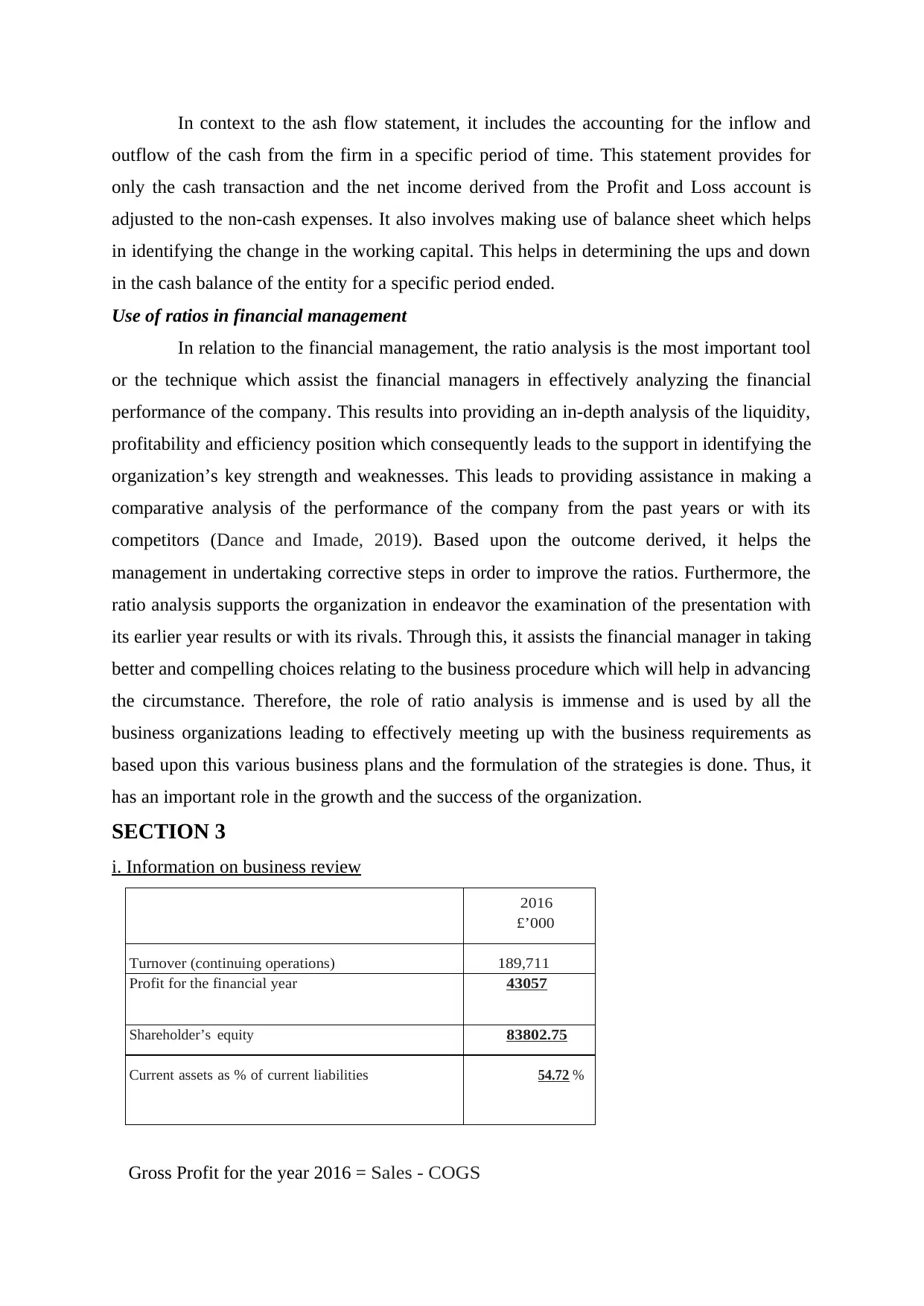
In context to the ash flow statement, it includes the accounting for the inflow and
outflow of the cash from the firm in a specific period of time. This statement provides for
only the cash transaction and the net income derived from the Profit and Loss account is
adjusted to the non-cash expenses. It also involves making use of balance sheet which helps
in identifying the change in the working capital. This helps in determining the ups and down
in the cash balance of the entity for a specific period ended.
Use of ratios in financial management
In relation to the financial management, the ratio analysis is the most important tool
or the technique which assist the financial managers in effectively analyzing the financial
performance of the company. This results into providing an in-depth analysis of the liquidity,
profitability and efficiency position which consequently leads to the support in identifying the
organization’s key strength and weaknesses. This leads to providing assistance in making a
comparative analysis of the performance of the company from the past years or with its
competitors (Dance and Imade, 2019). Based upon the outcome derived, it helps the
management in undertaking corrective steps in order to improve the ratios. Furthermore, the
ratio analysis supports the organization in endeavor the examination of the presentation with
its earlier year results or with its rivals. Through this, it assists the financial manager in taking
better and compelling choices relating to the business procedure which will help in advancing
the circumstance. Therefore, the role of ratio analysis is immense and is used by all the
business organizations leading to effectively meeting up with the business requirements as
based upon this various business plans and the formulation of the strategies is done. Thus, it
has an important role in the growth and the success of the organization.
SECTION 3
i. Information on business review
2016
£’000
Turnover (continuing operations) 189,711
Profit for the financial year 43057
Shareholder’s equity 83802.75
Current assets as % of current liabilities 54.72 %
Gross Profit for the year 2016 = Sales - COGS
outflow of the cash from the firm in a specific period of time. This statement provides for
only the cash transaction and the net income derived from the Profit and Loss account is
adjusted to the non-cash expenses. It also involves making use of balance sheet which helps
in identifying the change in the working capital. This helps in determining the ups and down
in the cash balance of the entity for a specific period ended.
Use of ratios in financial management
In relation to the financial management, the ratio analysis is the most important tool
or the technique which assist the financial managers in effectively analyzing the financial
performance of the company. This results into providing an in-depth analysis of the liquidity,
profitability and efficiency position which consequently leads to the support in identifying the
organization’s key strength and weaknesses. This leads to providing assistance in making a
comparative analysis of the performance of the company from the past years or with its
competitors (Dance and Imade, 2019). Based upon the outcome derived, it helps the
management in undertaking corrective steps in order to improve the ratios. Furthermore, the
ratio analysis supports the organization in endeavor the examination of the presentation with
its earlier year results or with its rivals. Through this, it assists the financial manager in taking
better and compelling choices relating to the business procedure which will help in advancing
the circumstance. Therefore, the role of ratio analysis is immense and is used by all the
business organizations leading to effectively meeting up with the business requirements as
based upon this various business plans and the formulation of the strategies is done. Thus, it
has an important role in the growth and the success of the organization.
SECTION 3
i. Information on business review
2016
£’000
Turnover (continuing operations) 189,711
Profit for the financial year 43057
Shareholder’s equity 83802.75
Current assets as % of current liabilities 54.72 %
Gross Profit for the year 2016 = Sales - COGS
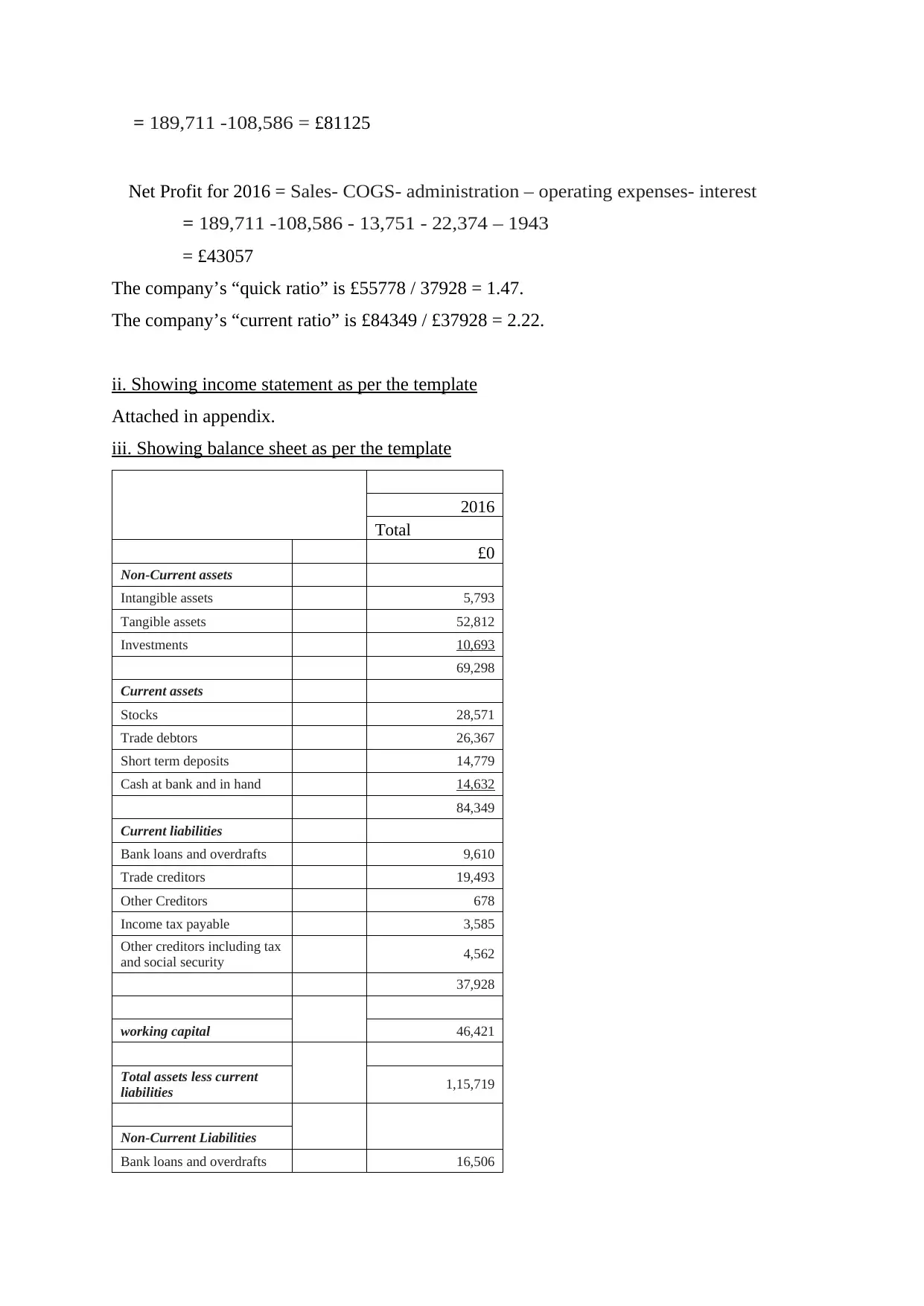
= 189,711 -108,586 = £81125
Net Profit for 2016 = Sales- COGS- administration – operating expenses- interest
= 189,711 -108,586 - 13,751 - 22,374 – 1943
= £43057
The company’s “quick ratio” is £55778 / 37928 = 1.47.
The company’s “current ratio” is £84349 / £37928 = 2.22.
ii. Showing income statement as per the template
Attached in appendix.
iii. Showing balance sheet as per the template
2016
Total
£0
Non-Current assets
Intangible assets 5,793
Tangible assets 52,812
Investments 10,693
69,298
Current assets
Stocks 28,571
Trade debtors 26,367
Short term deposits 14,779
Cash at bank and in hand 14,632
84,349
Current liabilities
Bank loans and overdrafts 9,610
Trade creditors 19,493
Other Creditors 678
Income tax payable 3,585
Other creditors including tax
and social security 4,562
37,928
working capital 46,421
Total assets less current
liabilities 1,15,719
Non-Current Liabilities
Bank loans and overdrafts 16,506
Net Profit for 2016 = Sales- COGS- administration – operating expenses- interest
= 189,711 -108,586 - 13,751 - 22,374 – 1943
= £43057
The company’s “quick ratio” is £55778 / 37928 = 1.47.
The company’s “current ratio” is £84349 / £37928 = 2.22.
ii. Showing income statement as per the template
Attached in appendix.
iii. Showing balance sheet as per the template
2016
Total
£0
Non-Current assets
Intangible assets 5,793
Tangible assets 52,812
Investments 10,693
69,298
Current assets
Stocks 28,571
Trade debtors 26,367
Short term deposits 14,779
Cash at bank and in hand 14,632
84,349
Current liabilities
Bank loans and overdrafts 9,610
Trade creditors 19,493
Other Creditors 678
Income tax payable 3,585
Other creditors including tax
and social security 4,562
37,928
working capital 46,421
Total assets less current
liabilities 1,15,719
Non-Current Liabilities
Bank loans and overdrafts 16,506
⊘ This is a preview!⊘
Do you want full access?
Subscribe today to unlock all pages.

Trusted by 1+ million students worldwide
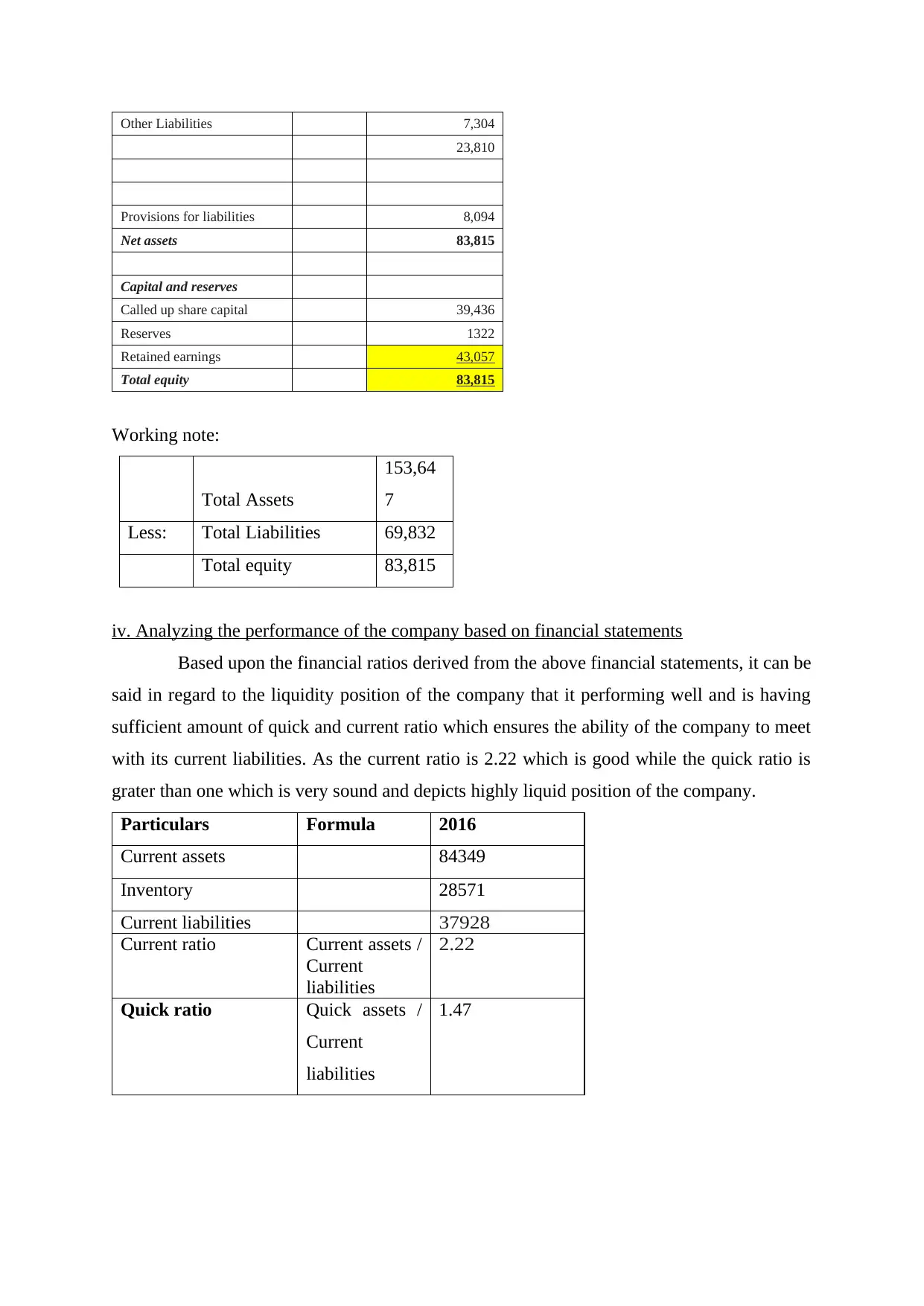
Other Liabilities 7,304
23,810
Provisions for liabilities 8,094
Net assets 83,815
Capital and reserves
Called up share capital 39,436
Reserves 1322
Retained earnings 43,057
Total equity 83,815
Working note:
Total Assets
153,64
7
Less: Total Liabilities 69,832
Total equity 83,815
iv. Analyzing the performance of the company based on financial statements
Based upon the financial ratios derived from the above financial statements, it can be
said in regard to the liquidity position of the company that it performing well and is having
sufficient amount of quick and current ratio which ensures the ability of the company to meet
with its current liabilities. As the current ratio is 2.22 which is good while the quick ratio is
grater than one which is very sound and depicts highly liquid position of the company.
Particulars Formula 2016
Current assets 84349
Inventory 28571
Current liabilities 37928
Current ratio Current assets /
Current
liabilities
2.22
Quick ratio Quick assets /
Current
liabilities
1.47
23,810
Provisions for liabilities 8,094
Net assets 83,815
Capital and reserves
Called up share capital 39,436
Reserves 1322
Retained earnings 43,057
Total equity 83,815
Working note:
Total Assets
153,64
7
Less: Total Liabilities 69,832
Total equity 83,815
iv. Analyzing the performance of the company based on financial statements
Based upon the financial ratios derived from the above financial statements, it can be
said in regard to the liquidity position of the company that it performing well and is having
sufficient amount of quick and current ratio which ensures the ability of the company to meet
with its current liabilities. As the current ratio is 2.22 which is good while the quick ratio is
grater than one which is very sound and depicts highly liquid position of the company.
Particulars Formula 2016
Current assets 84349
Inventory 28571
Current liabilities 37928
Current ratio Current assets /
Current
liabilities
2.22
Quick ratio Quick assets /
Current
liabilities
1.47
Paraphrase This Document
Need a fresh take? Get an instant paraphrase of this document with our AI Paraphraser
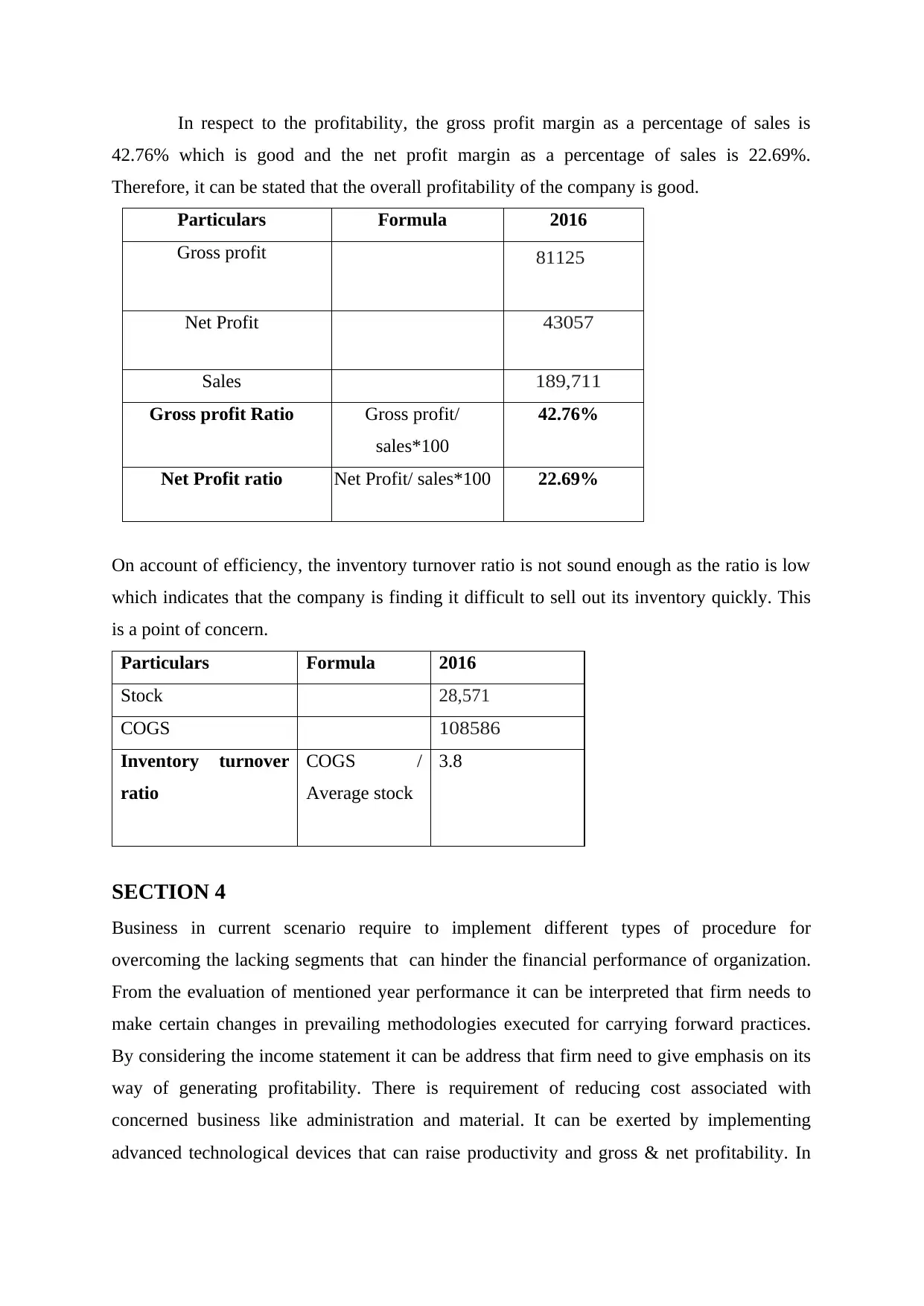
In respect to the profitability, the gross profit margin as a percentage of sales is
42.76% which is good and the net profit margin as a percentage of sales is 22.69%.
Therefore, it can be stated that the overall profitability of the company is good.
Particulars Formula 2016
Gross profit 81125
Net Profit 43057
Sales 189,711
Gross profit Ratio Gross profit/
sales*100
42.76%
Net Profit ratio Net Profit/ sales*100 22.69%
On account of efficiency, the inventory turnover ratio is not sound enough as the ratio is low
which indicates that the company is finding it difficult to sell out its inventory quickly. This
is a point of concern.
Particulars Formula 2016
Stock 28,571
COGS 108586
Inventory turnover
ratio
COGS /
Average stock
3.8
SECTION 4
Business in current scenario require to implement different types of procedure for
overcoming the lacking segments that can hinder the financial performance of organization.
From the evaluation of mentioned year performance it can be interpreted that firm needs to
make certain changes in prevailing methodologies executed for carrying forward practices.
By considering the income statement it can be address that firm need to give emphasis on its
way of generating profitability. There is requirement of reducing cost associated with
concerned business like administration and material. It can be exerted by implementing
advanced technological devices that can raise productivity and gross & net profitability. In
42.76% which is good and the net profit margin as a percentage of sales is 22.69%.
Therefore, it can be stated that the overall profitability of the company is good.
Particulars Formula 2016
Gross profit 81125
Net Profit 43057
Sales 189,711
Gross profit Ratio Gross profit/
sales*100
42.76%
Net Profit ratio Net Profit/ sales*100 22.69%
On account of efficiency, the inventory turnover ratio is not sound enough as the ratio is low
which indicates that the company is finding it difficult to sell out its inventory quickly. This
is a point of concern.
Particulars Formula 2016
Stock 28,571
COGS 108586
Inventory turnover
ratio
COGS /
Average stock
3.8
SECTION 4
Business in current scenario require to implement different types of procedure for
overcoming the lacking segments that can hinder the financial performance of organization.
From the evaluation of mentioned year performance it can be interpreted that firm needs to
make certain changes in prevailing methodologies executed for carrying forward practices.
By considering the income statement it can be address that firm need to give emphasis on its
way of generating profitability. There is requirement of reducing cost associated with
concerned business like administration and material. It can be exerted by implementing
advanced technological devices that can raise productivity and gross & net profitability. In
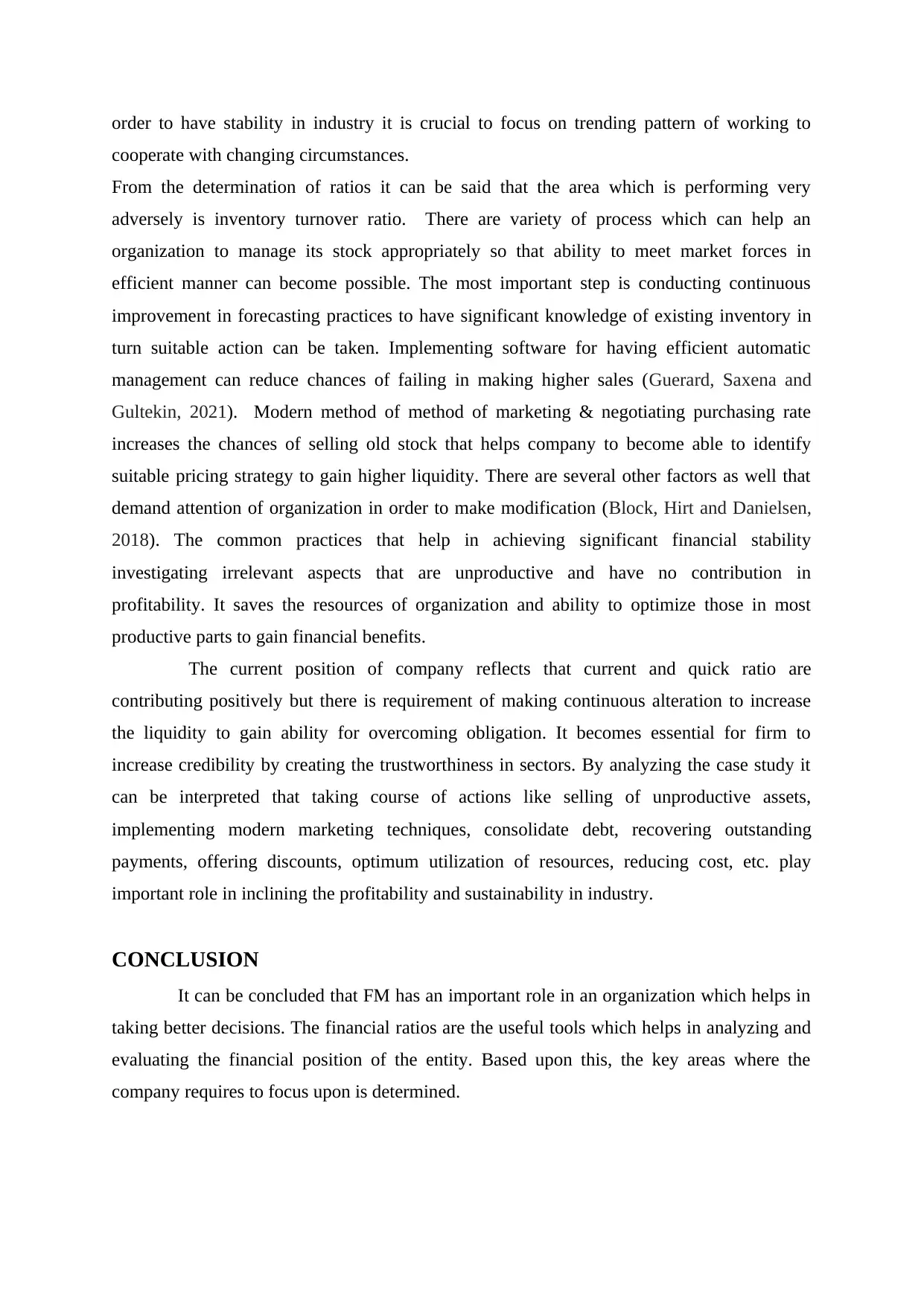
order to have stability in industry it is crucial to focus on trending pattern of working to
cooperate with changing circumstances.
From the determination of ratios it can be said that the area which is performing very
adversely is inventory turnover ratio. There are variety of process which can help an
organization to manage its stock appropriately so that ability to meet market forces in
efficient manner can become possible. The most important step is conducting continuous
improvement in forecasting practices to have significant knowledge of existing inventory in
turn suitable action can be taken. Implementing software for having efficient automatic
management can reduce chances of failing in making higher sales (Guerard, Saxena and
Gultekin, 2021). Modern method of method of marketing & negotiating purchasing rate
increases the chances of selling old stock that helps company to become able to identify
suitable pricing strategy to gain higher liquidity. There are several other factors as well that
demand attention of organization in order to make modification (Block, Hirt and Danielsen,
2018). The common practices that help in achieving significant financial stability
investigating irrelevant aspects that are unproductive and have no contribution in
profitability. It saves the resources of organization and ability to optimize those in most
productive parts to gain financial benefits.
The current position of company reflects that current and quick ratio are
contributing positively but there is requirement of making continuous alteration to increase
the liquidity to gain ability for overcoming obligation. It becomes essential for firm to
increase credibility by creating the trustworthiness in sectors. By analyzing the case study it
can be interpreted that taking course of actions like selling of unproductive assets,
implementing modern marketing techniques, consolidate debt, recovering outstanding
payments, offering discounts, optimum utilization of resources, reducing cost, etc. play
important role in inclining the profitability and sustainability in industry.
CONCLUSION
It can be concluded that FM has an important role in an organization which helps in
taking better decisions. The financial ratios are the useful tools which helps in analyzing and
evaluating the financial position of the entity. Based upon this, the key areas where the
company requires to focus upon is determined.
cooperate with changing circumstances.
From the determination of ratios it can be said that the area which is performing very
adversely is inventory turnover ratio. There are variety of process which can help an
organization to manage its stock appropriately so that ability to meet market forces in
efficient manner can become possible. The most important step is conducting continuous
improvement in forecasting practices to have significant knowledge of existing inventory in
turn suitable action can be taken. Implementing software for having efficient automatic
management can reduce chances of failing in making higher sales (Guerard, Saxena and
Gultekin, 2021). Modern method of method of marketing & negotiating purchasing rate
increases the chances of selling old stock that helps company to become able to identify
suitable pricing strategy to gain higher liquidity. There are several other factors as well that
demand attention of organization in order to make modification (Block, Hirt and Danielsen,
2018). The common practices that help in achieving significant financial stability
investigating irrelevant aspects that are unproductive and have no contribution in
profitability. It saves the resources of organization and ability to optimize those in most
productive parts to gain financial benefits.
The current position of company reflects that current and quick ratio are
contributing positively but there is requirement of making continuous alteration to increase
the liquidity to gain ability for overcoming obligation. It becomes essential for firm to
increase credibility by creating the trustworthiness in sectors. By analyzing the case study it
can be interpreted that taking course of actions like selling of unproductive assets,
implementing modern marketing techniques, consolidate debt, recovering outstanding
payments, offering discounts, optimum utilization of resources, reducing cost, etc. play
important role in inclining the profitability and sustainability in industry.
CONCLUSION
It can be concluded that FM has an important role in an organization which helps in
taking better decisions. The financial ratios are the useful tools which helps in analyzing and
evaluating the financial position of the entity. Based upon this, the key areas where the
company requires to focus upon is determined.
⊘ This is a preview!⊘
Do you want full access?
Subscribe today to unlock all pages.

Trusted by 1+ million students worldwide
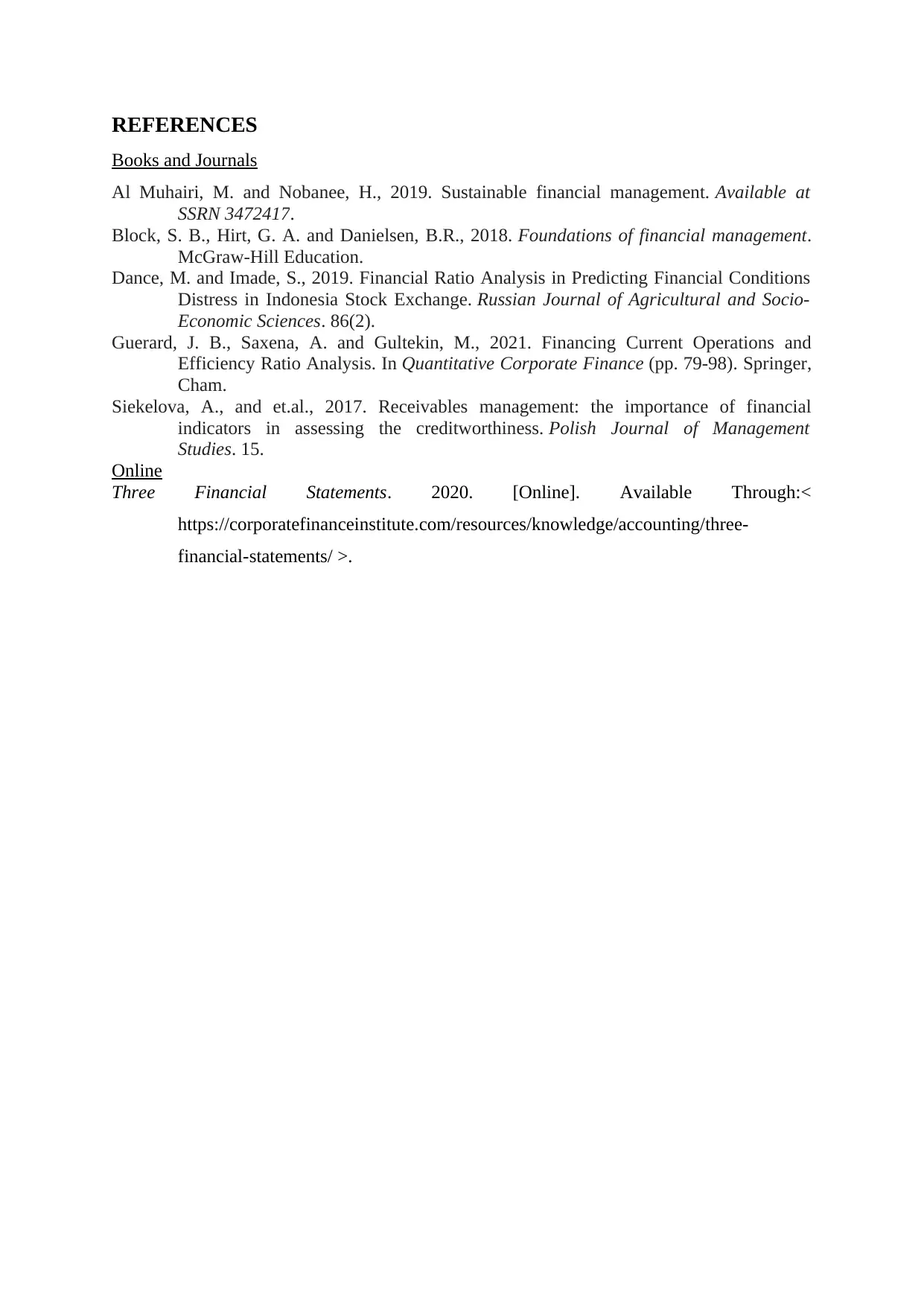
REFERENCES
Books and Journals
Al Muhairi, M. and Nobanee, H., 2019. Sustainable financial management. Available at
SSRN 3472417.
Block, S. B., Hirt, G. A. and Danielsen, B.R., 2018. Foundations of financial management.
McGraw-Hill Education.
Dance, M. and Imade, S., 2019. Financial Ratio Analysis in Predicting Financial Conditions
Distress in Indonesia Stock Exchange. Russian Journal of Agricultural and Socio-
Economic Sciences. 86(2).
Guerard, J. B., Saxena, A. and Gultekin, M., 2021. Financing Current Operations and
Efficiency Ratio Analysis. In Quantitative Corporate Finance (pp. 79-98). Springer,
Cham.
Siekelova, A., and et.al., 2017. Receivables management: the importance of financial
indicators in assessing the creditworthiness. Polish Journal of Management
Studies. 15.
Online
Three Financial Statements. 2020. [Online]. Available Through:<
https://corporatefinanceinstitute.com/resources/knowledge/accounting/three-
financial-statements/ >.
Books and Journals
Al Muhairi, M. and Nobanee, H., 2019. Sustainable financial management. Available at
SSRN 3472417.
Block, S. B., Hirt, G. A. and Danielsen, B.R., 2018. Foundations of financial management.
McGraw-Hill Education.
Dance, M. and Imade, S., 2019. Financial Ratio Analysis in Predicting Financial Conditions
Distress in Indonesia Stock Exchange. Russian Journal of Agricultural and Socio-
Economic Sciences. 86(2).
Guerard, J. B., Saxena, A. and Gultekin, M., 2021. Financing Current Operations and
Efficiency Ratio Analysis. In Quantitative Corporate Finance (pp. 79-98). Springer,
Cham.
Siekelova, A., and et.al., 2017. Receivables management: the importance of financial
indicators in assessing the creditworthiness. Polish Journal of Management
Studies. 15.
Online
Three Financial Statements. 2020. [Online]. Available Through:<
https://corporatefinanceinstitute.com/resources/knowledge/accounting/three-
financial-statements/ >.
Paraphrase This Document
Need a fresh take? Get an instant paraphrase of this document with our AI Paraphraser
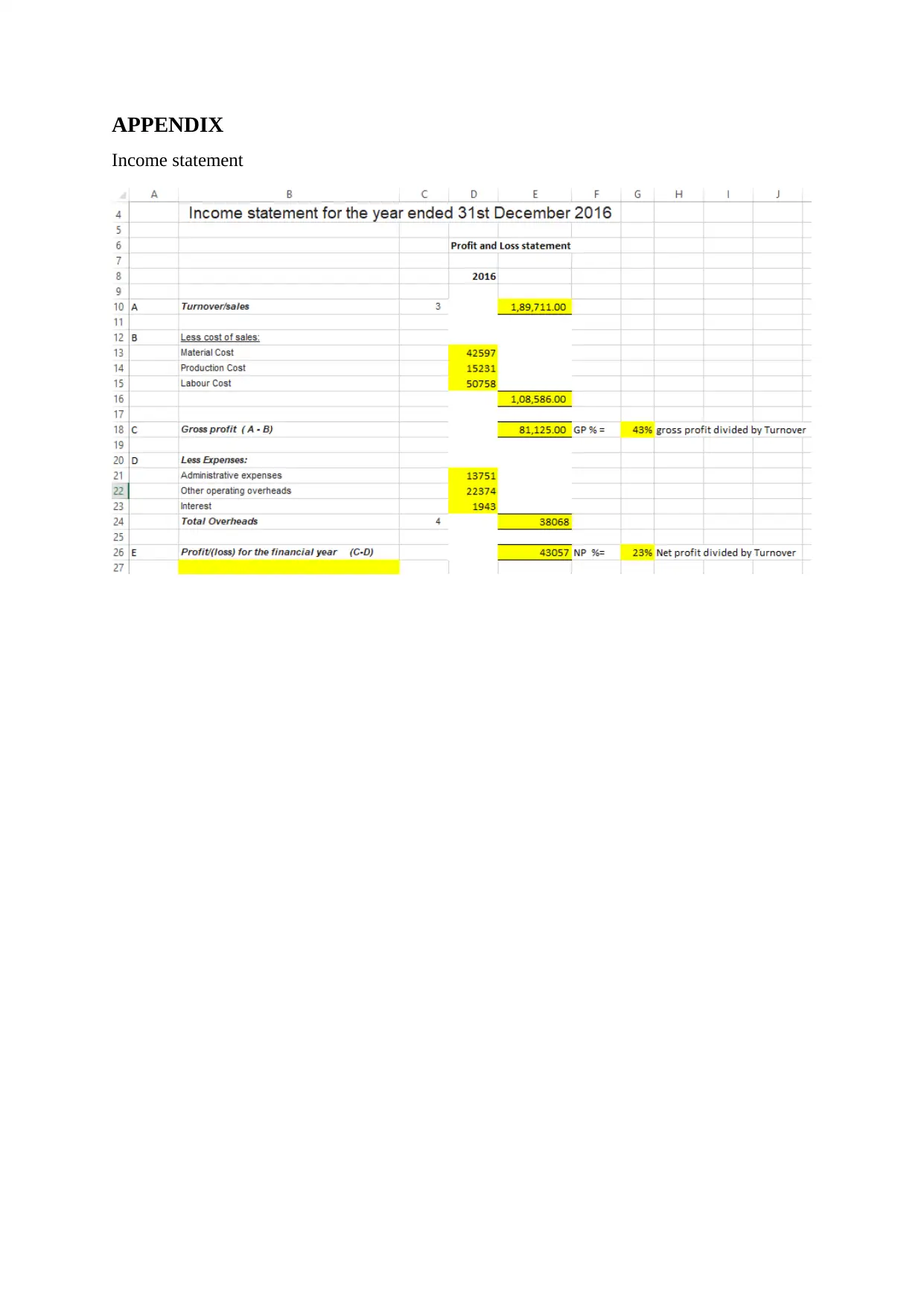
APPENDIX
Income statement
Income statement

⊘ This is a preview!⊘
Do you want full access?
Subscribe today to unlock all pages.

Trusted by 1+ million students worldwide
1 out of 12
Related Documents
Your All-in-One AI-Powered Toolkit for Academic Success.
+13062052269
info@desklib.com
Available 24*7 on WhatsApp / Email
![[object Object]](/_next/static/media/star-bottom.7253800d.svg)
Unlock your academic potential
Copyright © 2020–2025 A2Z Services. All Rights Reserved. Developed and managed by ZUCOL.



